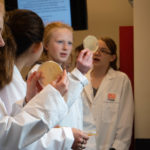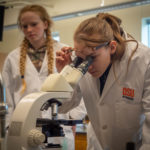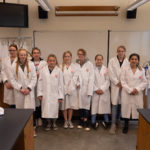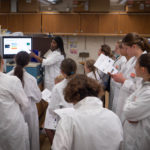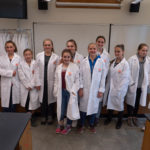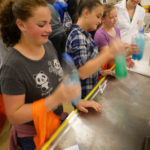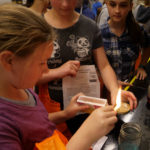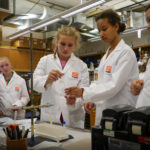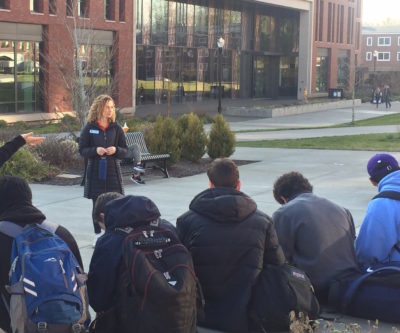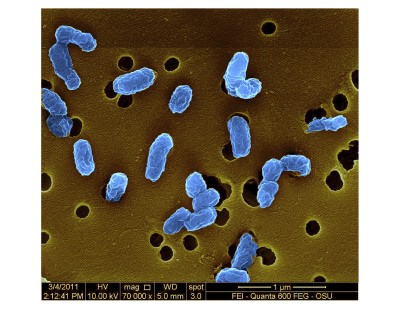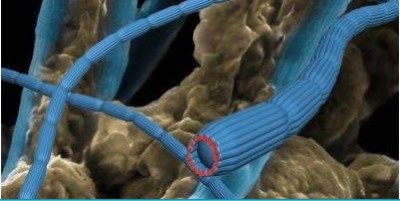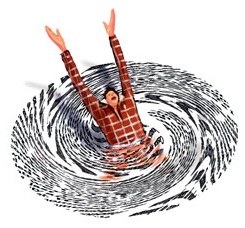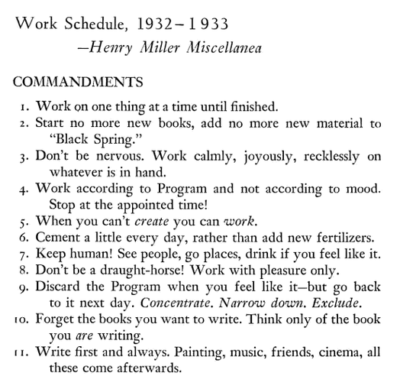Dr. James Fox created a fun and informative game to help people of all ages learn about carbon transformations in the ocean. There are some fun activities sprinkled throughout and it has a “Chutes and Ladders” theme to follow the fates of organic matter down into the deep ocean…or back up through a giant mixing event. Here, he and Ivona Cetinic (NASA Goddard) discuss oceanography, satellites, phytoplankton, and more.
You may catch a few glimpses of us in this College of Science video…
Bryce and James are OMSI Fellows
Grad student, Bryce Penta, and Post-doc, James Fox, were funded through the NASA @ My Library scholarship to attend the OMSI (Oregon Museum of Science and Industry) Science Communication Fellowship program. Through workshops and intensive discussions, fellows develop hands-on displays for students of all ages to learn about current research. Their displays help students learn about how satellite images are used to measure phytoplankton distributions and carbon cycling in the ocean. Pictures and descriptions of the display coming soon! They demo these project at local and regional events.
Reaching out to rural Oregon
The STEM girls club from Hanby Middle School in Oregon visited OSU’s Department of Microbiology in April, 2018. Our lab hosted the visit and arranged for students to see and experience science in the teaching labs and two research labs. The girls observed microbes and performed short experiments. Dr. Cleo Davie-Martin gave students the opportunity to explore cloud formation and discussed the roles of algae in producing cloud-producing molecules (click here for a worksheet for this hands-on learning activity). Dr. Nicole Ham explained how fluorescent proteins are used as tools in microbiological research, and students purified GFP and RFP at the research bench. The girls’ intent expressions were captured for us in the following photo gallery (courtesy of Christien Laber).
- Viewing microbes on Petri dishes
- Magnifying the microscopic
- Future Microbiologists?
- Dr. Nicole Ham explaining fluorescent proteins as tools in microbiology
- Budding scientists
- Dr. Cleo Davie-Martin overseeing students creating clouds-in-bottles
- Temperature is key in cloud formation
- Collaboration
- Eluting fluorescent proteins from a column
Outreach via media:
Occasional Blogs From the Field ~
- By Dr. Cleo Davie Martin aboard the R/V Atlantis during NAAMES #4: https://earthobservatory.nasa.gov/blogs/fromthefield/2018/04/04/naames-iv-expedition-april-3-2018/
- By Dr. Kim Halsey aboard the R/V Atlantis during NAAMES #4: https://earthobservatory.nasa.gov/blogs/fromthefield/2018/04/02/naames-iv-expedition-march-31-2018/
- By Eric Moore, Ph.D. candidate aboard the R/V Atlantis during NAAMES #4: https://earthobservatory.nasa.gov/blogs/fromthefield/2018/03/26/naames-iv-expedition-march-23-2018/
- By Bryce Penta, Ph.D. candidate aboard the R/V Atlantis during NAAMES #4: https://earthobservatory.nasa.gov/blogs/fromthefield/2018/03/23/naames-iv-expedition-march-20-2018/
Radio ~
Our discoveries that the centric diatom Thalassiosira pseudonana has a functional sexual pathway and that ammonium reliably triggers this species and several others into sexuality received a fair bit of press. OSU’s Steve Lundeberg’s news release started the news trending…
Diatoms have sex after all, and ammonium puts them in the mood
And then, NPR’s Science Friday invited me on the air for a little chat about it:
Listen here to the epidsode
On Campus ~
Some of our best outreach ambassadors are the undergraduates participating in research projects in my lab. I was walking on campus today and saw Emma Tornberg giving a campus tour to visiting students considering OSU. Emma completed her Honors College thesis work in my lab, and worked part time for OSU’s Office of Admissions as a TOUR Ambassador and Student Coordinator. I cannot imagine a better person to represent OSU.
Courses I teach:
General Microbiology (MB 302, Fall terms) ~
This course describes microbial cytology, physiology, evolutionary relationships, growth and control of growth. The roles of microorganisms in nature, in disease, and as useful tools in biotechnology are discussed. Of particular interest is metabolic diversity. Specific examples of unique microbial processes are presented.
The foundational course required for all MB, FST, IB, and BHS majors. It also draws students from ANS, FW, BPP, and others.
Supplementary curriculum (videos, pdfs, news articles, etc.)
Forms of motility:
E. coli: notice peritrichous flagella bunching into a “pony tail” during runs. fluo_ecoli
Gliding motility: fluorescent beads help show “tractor track” proteins. cytophaga_beads
Don’t blink, this one is quick…twitching
Synechococcus unknown mechanism for motility: synecho_swim
Other stories about amazing microbes…
Wolbachia and Dengue Fever, NPR segment
Spores working as machines, New York Times video
Microbial Ecology (MB 448/548, Winter terms) ~ 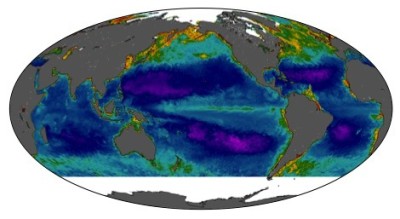
This course examines the physical, chemical, and biological factors responsible for changes in the distributions and activities of microbes in soil and aquatic environments. The course aims to provide an overview of 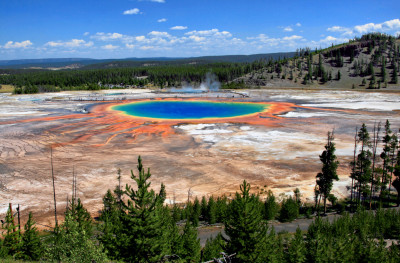 physiological ecology including metabolic strategies of microbes and their interactions that are strongly rooted in energetics. Environmental heterogeneity across broad scales (i.e., from the molecular to the global) is emphasized to reveal physiological flexibility within a single organism and adaptive strategies that allow microbes to optimize growth in their dynamic environments.
physiological ecology including metabolic strategies of microbes and their interactions that are strongly rooted in energetics. Environmental heterogeneity across broad scales (i.e., from the molecular to the global) is emphasized to reveal physiological flexibility within a single organism and adaptive strategies that allow microbes to optimize growth in their dynamic environments.
This course encourages active participation of students with separate break out discussions with undergraduates and graduates. Microbial Ecology draws students from MB, BEE, CBEE, CSS, CEOAS, FW, and others.
Supplementary curriculum (cool stuff):
1977_Purcell_life_at_low_reynolds_number, A physicists view of microbial movement.
Scientific Skills (MB 511, Fall terms) ~
This course provides practical information for incoming graduate students to alleviate confusion and anxiety about processes that are common to all students as they chart their paths through graduate school. This course advises about strategies that enhance success in advanced degree programs and provides students with key tools, such as effective literature search and management methods and presentation skills that are essential during graduate school. A key goal is to develop a strong cohort that students can tap for assistance and support throughout their graduate school years. This course is open to all majors.
Presentations..What makes presentations make you sit up and take notice? I’ve been thinking about this quite a bit lately, and OSU was lucky enough to get a visit from Ira Glass who gave an entertaining lecture on story telling. There were so many great tidbits there, that I searched around for some of them online, and found this great resource…on “How to Tell a Good Story”
Writing, writing, writing. It is painful and then becomes exhilarating. I have to trust in the process – and to do so, follow some rules. They work!
